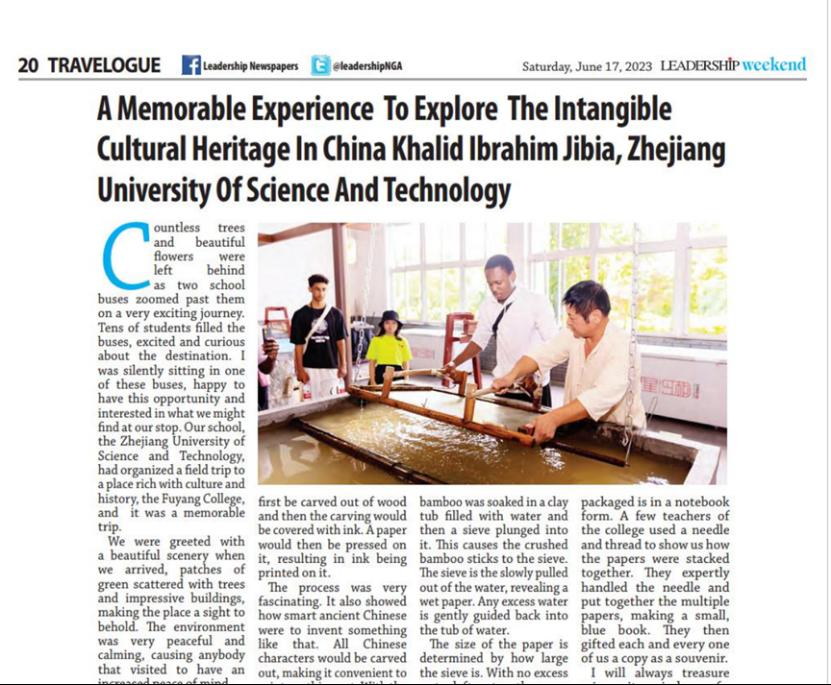
A memorable experience to explore the intangible heritage in China
Khalid Ibrahim Jibia
Countless trees and beautiful flowers were left behind as two school buses zoomed past them on a very exciting journey. Tens of students filled the buses, excited and curious about the destination. I was silently sitting in one of these buses, happy to have this opportunity and interested in what we might find at our stop. Our school, the Zhejiang University of Science and Technology, had organized a field trip to a place rich with culture and history, the Fuyang College, and it was a memorable trip.
We were greeted with a beautiful scenery when we arrived, patches of green scattered with trees and impressive buildings, making the place a sight to behold. The environment was very peaceful and calming, causing anybody that visited to have an increased peace of mind.
A few officials came out and warmly greeted us, then led us in. There we met the principal and other teachers. We were, once again, welcomed to their college as they began to give us an introduction to their college.
The college is an intangible cultural heritage inheritance school located in Fuyang , Hangzhou. It has two campuses, one local and one outside. It is also very accomplished, winning multiple championships over the years. And then, the fun part of the trip began.
An exhibition began, showcasing the culture of Fuyang and, most importantly, China. The four great inventions of ancient China are: papermaking, printing, gunpowder, and the compass. We got to witness two of those magnificent inventions – papermaking, and printing.
We first saw how printing was carried out in ancient China. Characters would first be carved out of wood and then the carving would be covered with ink. A paper would then be pressed on it, resulting in ink being printed on it.
The process was very fascinating. It also showed how smart ancient Chinese were to invent something like that. All Chinese characters would be carved out, making it convenient to print anything out. With the advancements of carpentry, now even cartoon characters can be printed out. The famous Chenchen, one of the Asian Games’ mascots, was printed out in front of us. It was printed out on the rice paper, another one of ancient China’s great inventions.
The showcasing of the papermaking was also interesting. Crushed bamboo was soaked in a clay tub filled with water and then a sieve plunged into it. This causes the crushed bamboo sticks to the sieve. The sieve is the slowly pulled out of the water, revealing a wet paper. Any excess water is gently guided back into the tub of water.

The size of the paper is determined by how large the sieve is. With no excess water left on top, the paper is peeled out from the sieve before being dried, ready to be used for many different purposes - calligraphy, painting, literature and so on, the possibilities are many. I volunteered to do the process up close with the help of one of the teachers, and it was quite exciting.
One of the more common ways the papers are packaged is in a notebook form. A few teachers of the college used a needle and thread to show us how the papers were stacked together. They expertly handled the needle and put together the multiple papers, making a small, blue book. They then gifted each and every one of us a copy as a souvenir.
I will always treasure mine as it reminds me of a time, a time I first handedly experienced Fuyang’s, but most importantly, China’s culture. It also reminds me that even an inconspicuous part of China, may have a deep history and fascinating culture. This deepens my respect for China and increases my drive to explore as many parts of it as I can.
原文链接:
https://leadership.ng/a-memorable-experience-to-explore-the-intangible-cultural-heritage-in-china-khalid-ibrahim-jibia-zhejiang-university-of-science-and-technology/